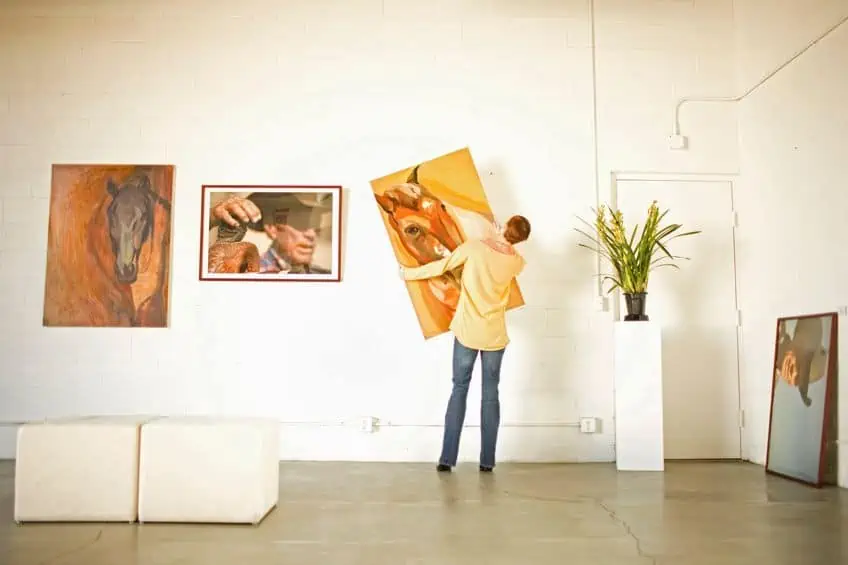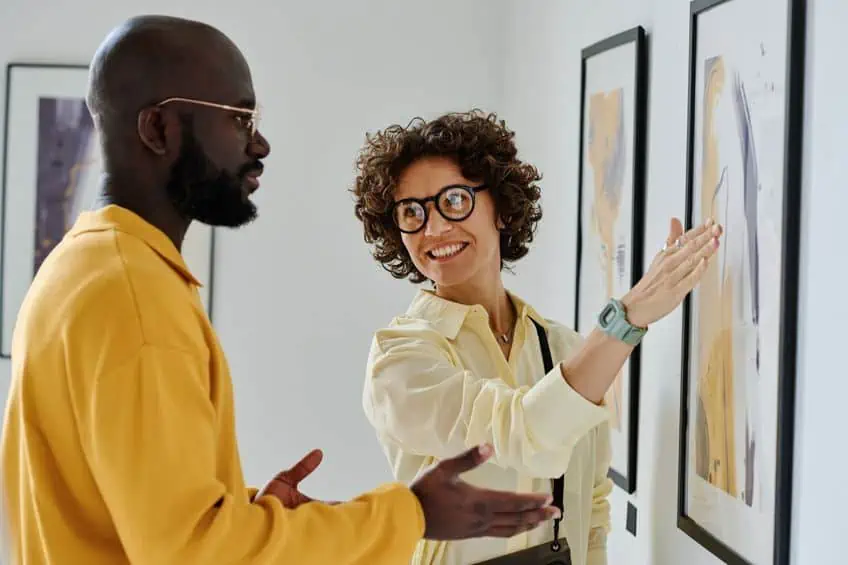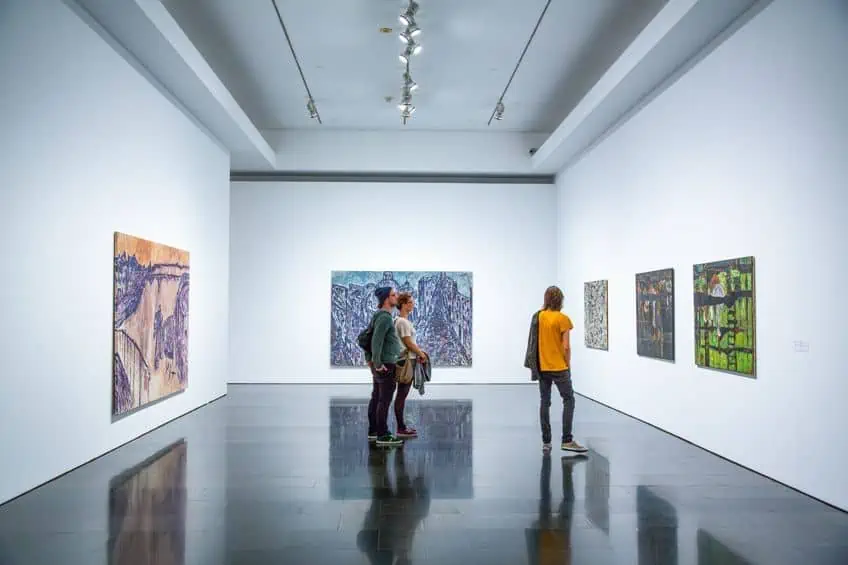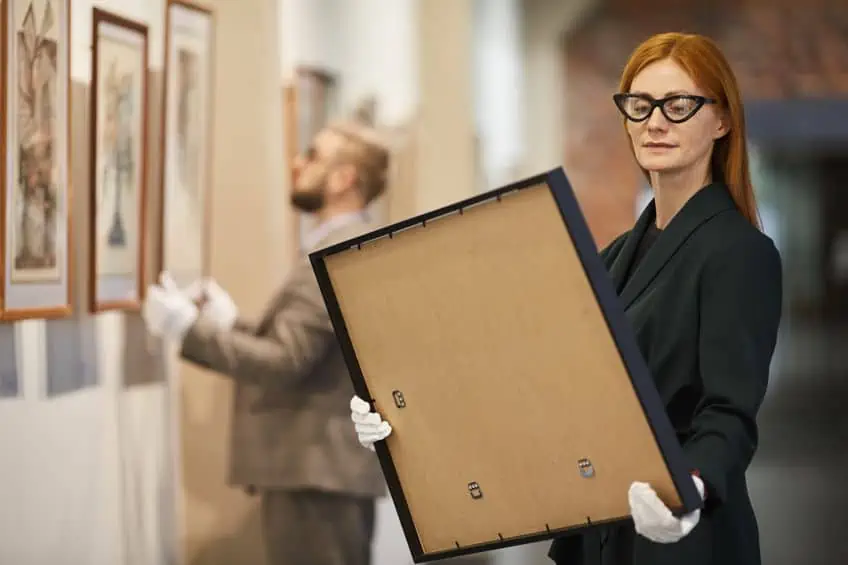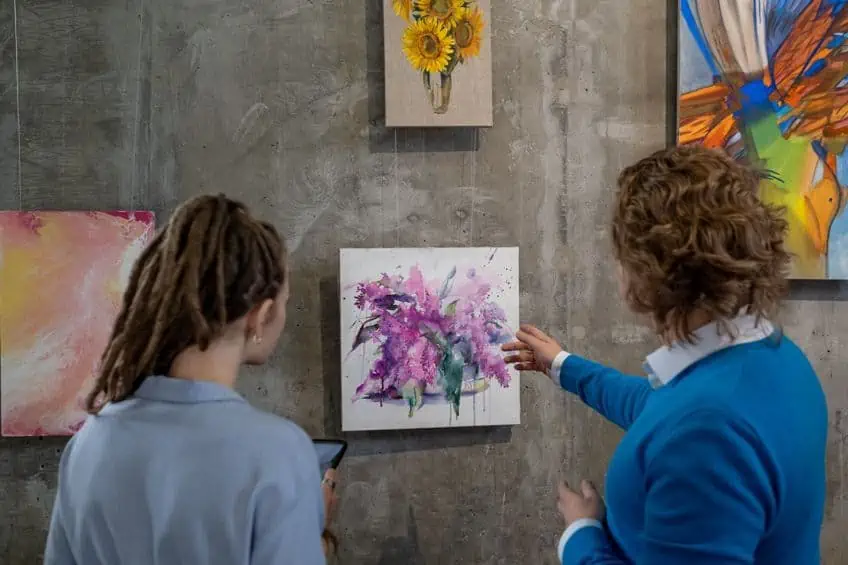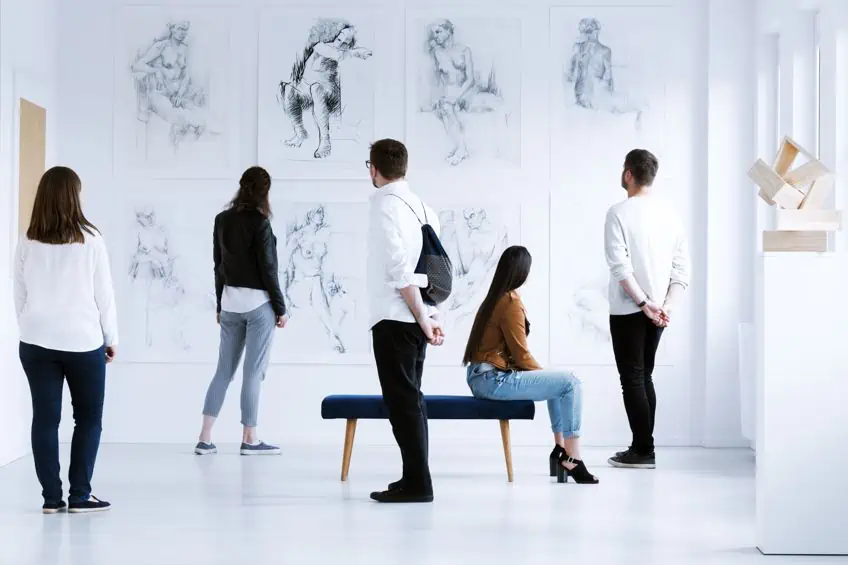What Is Curating in Art? – Creating Impactful Art Collections
In the multifaceted world of art, the concept of curation plays a pivotal role, raising questions such as “What does curation mean?”, “what is an art curator?”, and “why is curating art important?”. Moreover, what is the difference between curating and art collecting? In this article, titled “What is curating in art”, we delve into these intriguing questions, unraveling the essence of curating in art and its significance in shaping the artistic narrative.
Contents
What Is Curating in Art?
Curating in the context of art refers to the thoughtful selection, arrangement, and presentation of artworks in exhibitions or collections. It involves the careful consideration of artistic themes, historical context, and visual aesthetics to create a meaningful and cohesive artistic experience for viewers.
Curating holds immense importance in today’s world for several compelling reasons. Curators act as guides in an age inundated with information and images, offering valuable context to help audiences navigate the artistic landscape and comprehend the cultural, historical, and social significance of artworks. Curators have the power to boost underrepresented stories and encourage inclusivity in the art world, fostering a more equitable cultural discourse.
These are just a few reasons that demonstrate why curating art is important. The rest of this article will reveal more details.
Understanding Curating: What Does Curation Mean?
In the realm of art and culture, the term “curation” has evolved into a buzzword, often conjuring images of meticulously arranged exhibitions in museums or thoughtfully designed galleries. But what does curation truly mean, and why is it so essential in the contemporary world?
Definition and Explanation of Curating
At its core, curation refers to the art of choosing, organizing, and showing a collection of items or artifacts, often with a particular theme or narrative in mind. While curation can encompass various fields, from fashion to music, we’ll primarily focus on its significance in the context of art. Curators, the individuals responsible for this intricate task, serve as guides in a world flooded with visual stimuli. They provide context, offering viewers a deeper understanding of the cultural, historical, and social significance of the artworks on display.
In an era marked by information overload and constant distractions, curation provides a curated, meaningful experience, allowing audiences to engage more deeply with the art.
How Curating Impacts the Art World and Other Industries
Curating extends its influence far beyond the walls of art galleries and museums. Here are some ways in which it leaves an indelible mark:
- Cultural preservation: Curators are stewards of cultural heritage, safeguarding the legacy of artists and preserving artworks for future generations.
- Inclusivity and diversity: Curators have the power to highlight and tell underrepresented narratives and foster inclusivity in the art world, fostering a more equitable cultural discourse.
- Critical discourse: Curators shape public opinion and stimulate critical discourse by curating exhibitions that challenge conventions and encourage reflection and dialogue.
- Innovation: They introduce new artistic trends and talents, encouraging creativity and experimentation.
- Economic impact: Curated exhibitions attract visitors, generate tourism earnings, and grow local economies.
- Education and engagement: Curated exhibitions serve as valuable educational tools, inspiring learning, curiosity, and engagement among diverse audiences.
The Process of Curating: How to Curate Art
Curating art is a delicate and intricate process that goes far beyond simply hanging paintings on a gallery wall. It involves meticulous research, thoughtful selection, creative arrangement, and a deep understanding of the context and narrative behind the artworks.
In this section of the article, we will explore the step-by-step process of curating art, from the initial research and selection to the final interpretation and presentation, highlighting successful curating efforts along the way.
Research and Selection
The journey of curating begins with comprehensive research. Curators must immerse themselves in the world of art, studying artists, movements, and themes. They explore a vast array of artworks, often visiting studios, galleries, and auction houses to identify pieces that align with their curatorial vision. This stage is crucial for curators to understand the historical, cultural, and social context of the artworks they plan to showcase.
Arrangement and Presentation
Once the selection is complete, curators turn their attention to the arrangement and presentation of the chosen artworks. This step involves the spatial design of the exhibition space, including the placement of artworks, lighting, and even the flow of the narrative. Curators must consider how each piece interacts with others, creating a cohesive and engaging visual experience for visitors.
The goal is to guide viewers through a meaningful journey that tells a story or explores a theme.
Interpreting and Contextualizing the Pieces
An essential aspect of curating is interpreting and contextualizing the pieces. Curators provide insights into the significance of each artwork, offering viewers a deeper understanding of its historical and cultural relevance. They often accompany exhibitions with explanatory texts, audio guides, or multimedia presentations to help visitors connect with the art on a profound level. This step bridges the gap between the art and the audience, enhancing the overall experience.
Examples of Successful Curating Efforts
Several notable examples of successful curating efforts stand as testaments to the art of curation’s impact:
- The Treasures of Tutankhamun (1972): This iconic exhibition showcased the artifacts from the tomb of King Tutankhamun, captivating audiences worldwide. The careful curation and presentation of these ancient treasures made history come alive.
- Sensation: Young British Artists from the Saatchi Collection (1997): This exhibition at the Royal Academy in London introduced the world to the provocative works of emerging British artists, igniting a global conversation about contemporary art.
- The Artist is Present (2010): Curated by MoMA, this exhibition featuring the performance art of Marina Abramović drew record crowds. It exemplified how curation can transform performance art into a mesmerizing museum experience.
- The Steins Collect (2011): This exhibition at the Metropolitan Museum of Art in New York celebrated the art collection of the Stein family, who were early patrons of modernist artists like Picasso and Matisse. The curation highlighted the family’s role in shaping the art world during the early 20th century.
Benefits of Curating: Why Is Curating Art Important?
Curating art transcends the role of simply arranging and displaying artworks; it plays a vital role in enriching society in numerous ways. From enhancing cultural awareness to fostering critical thinking, the importance of curating art cannot be overstated. In this section of the article, we will investigate the multifaceted advantages of curating and why it is a cornerstone of cultural enrichment.
Enhancing Cultural Awareness
One of the primary benefits of curating art is its ability to enhance cultural awareness. Through carefully curated exhibitions, viewers gain insights into diverse cultures, traditions, and perspectives. Artworks often serve as windows into the socio-cultural fabric of different societies, offering a glimpse into the values, beliefs, and experiences of people from around the world.
By engaging with art from various backgrounds, individuals can broaden their horizons, cultivate empathy, and develop a deeper appreciation for the rich tapestry of human diversity.
Preserving Cultural Heritage
Curating plays a crucial role in preserving cultural heritage. Curators act as custodians, safeguarding invaluable artworks and artifacts for future generations. By curating exhibitions and collections, they ensure that these cultural treasures are not lost to the sands of time. Through meticulous preservation efforts, curators help maintain a tangible link to our past, allowing us to connect with the artistic achievements of our ancestors and understand the evolution of culture over time.
Providing Educational Opportunities
Curating art provides invaluable educational opportunities. Museums and galleries curated with a thoughtful approach become immersive classrooms where visitors can learn about history, art movements, and societal changes. Many curators go beyond the exhibition walls by organizing workshops, lectures, and guided tours to deepen the educational impact.
These initiatives encourage lifelong learning and inspire curiosity among audiences of all ages.
Encouraging Critical Thinking and Creativity
Curated exhibitions often challenge viewers to immerse themselves in self-reflective thinking. Curators carefully select and arrange artworks to provoke thought, stimulate dialogue, and inspire creativity. By presenting art in thought-provoking ways, curators encourage viewers to question assumptions, explore new perspectives, and develop a more profound appreciation for the complexities of the human experience. This cultivation of critical thinking and creativity extends beyond the art world, benefiting individuals in various aspects of their lives.
Challenges and Best Practices in Curating Art
Curating art is a multifaceted endeavor that brings together creativity, expertise, and a deep appreciation for artistic expression. Yet, in the world of curating, challenges abound, and navigating them effectively is crucial to delivering impactful exhibitions and collections.
In this section of the article, we’ll explore some of the prominent challenges faced by curators and highlight best practices for addressing them.
Balancing Personal Taste and Audience Appeal
One of the foremost challenges in curating art is striking the delicate balance between personal taste and audience appeal. Curators are passionate individuals with their unique preferences, but they must curate with a broad audience in mind. The key is to curate art that resonates with personal conviction while considering the diverse tastes and interests of the intended viewers. Best practice here involves engaging in extensive research to understand the audience’s preferences and selecting artworks that both align with the curatorial vision and have the potential to engage and educate visitors.
Addressing Ethical Considerations
Ethical considerations in curating are of paramount importance. Curators often encounter questions related to provenance, cultural sensitivity, and authenticity. It’s vital to ensure that artworks are obtained ethically, with proper documentation of their history and ownership. When curating pieces with cultural significance, respect for the source culture and adherence to legal and ethical guidelines are essential.
Transparent communication with stakeholders and communities connected to the artworks can help navigate these complex ethical waters.
Staying Current and Relevant
Curators must keep their fingers on the pulse of contemporary art movements, emerging artists, and societal trends. Best practices include regular attendance at art fairs, galleries, and exhibitions, as well as networking with artists and fellow curators. Curators should also foster a commitment to lifelong learning, attending workshops and conferences to stay informed about new curatorial techniques and technologies.
Seeking Feedback and Collaboration
Curating art can sometimes be a solitary endeavor, but the input of others is invaluable. Seeking feedback from peers, artists, and the intended audience is a best practice that can help refine curatorial decisions. Collaboration is also key, as it can lead to innovative and inclusive exhibitions. Partnering with artists, scholars, and community organizations can enrich the curatorial process and result in exhibitions that resonate more deeply with viewers.
In conclusion, in the exploration of “What is curating in art”, an array of questions has been answered in this article, for example, “What does curation mean?,” “What is an art curator?,” “How to curate art,?” and, “Why is curating art important?”. Answering these questions has shed light on the dynamic and multifaceted world of art curation. It is evident that curating transcends mere art selection; it is a deliberate act of storytelling, cultural preservation, and education. In essence, curating art is a rich tapestry woven from creativity, historical context, and a commitment to enriching our understanding of the world through the language of art.
Frequently Asked Questions
What Does Curating Do?
Curating, in essence, serves as the guiding hand that shapes the narrative and meaning behind a collection of artworks or artifacts. It curates experiences by selecting, arranging, and presenting these pieces in a way that educates, inspires, and engages viewers. Curating unlocks the potential of art to convey cultural, historical, and emotional significance, cultivating a more in-depth comprehension of the world and its various viewpoints. Ultimately, curating cultivates understanding, providing a bridge between the artist’s intent and the audience’s interpretation, making it an invaluable force in the world of art and culture.
What Is the Difference Between Curating and Art Collecting?
The primary difference between curating and art collecting lies in their objectives and roles within the art world. Curating involves the thoughtful selection, arrangement, and presentation of artworks in a way that tells a story or conveys a specific theme, often in a public context like museums or galleries. Curators aim to create meaningful experiences that educates and engages audiences. In contrast, art collecting is the act of acquiring artworks for personal enjoyment, investment, or as a private possession. Collectors often follow their personal tastes and preferences and may not have a broader narrative or educational goal in mind. While both curators and collectors are passionate about art, their intentions and the impact of their actions differ significantly.
Nicolene Burger, a South African multimedia artist and creative consultant, specializes in oil painting and performance art. She earned her BA in Visual Arts from Stellenbosch University in 2017. Nicolene’s artistic journey includes exhibitions in South Korea, participation in the 2019 ICA Live Art Workshop, and solo exhibitions. She is currently pursuing a practice-based master’s degree in theater and performance. Nicolene focuses on fostering sustainable creative practices and offers coaching sessions for fellow artists, emphasizing the profound communicative power of art for healing and connection. Nicolene writes blog posts on art history for artfilemagazine with a focus on famous artists and contemporary art.
Learn more about Nicolene Burger and about us.
Cite this Article
Nicolene, Burger, “What Is Curating in Art? – Creating Impactful Art Collections.” artfilemagazine – Your Online Art Source. September 19, 2023. URL: https://artfilemagazine.com/what-is-curating-in-art/
Burger, N. (2023, 19 September). What Is Curating in Art? – Creating Impactful Art Collections. artfilemagazine – Your Online Art Source. https://artfilemagazine.com/what-is-curating-in-art/
Burger, Nicolene. “What Is Curating in Art? – Creating Impactful Art Collections.” artfilemagazine – Your Online Art Source, September 19, 2023. https://artfilemagazine.com/what-is-curating-in-art/.






